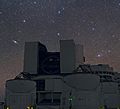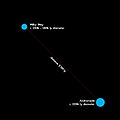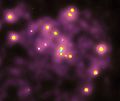Andromeda galaxy facts for kids
Quick facts for kids Andromeda Galaxy, M31 |
|
|---|---|
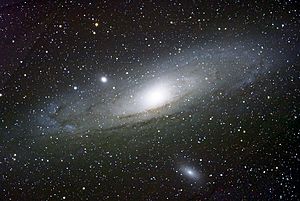
M31 or Andromeda Galaxy, a galaxy discovered by Azophi in year 964
|
|
| Observation data (J2000.0 epoch) | |
| Right ascension | 00h 42m 44.3s |
| Declination | ±41° 16′ 09″ |
| Redshift | -0.001001 |
| Distance | 2.5 millions of ly |
| Notable features | Most visible galaxy from the Earth |
| Other designations | |
| M31, NGC 224, UGC 454 | |
| Azophi | |
| See also: Galaxy, List of galaxies | |
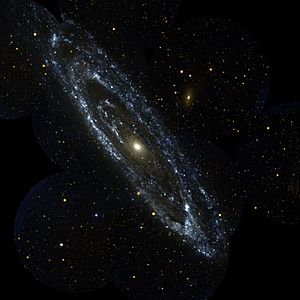
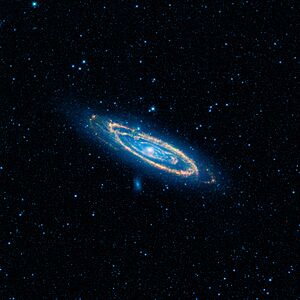
The Andromeda Galaxy is the closest big spiral galaxy to our own galaxy, the Milky Way. Scientists sometimes call it M31 or NGC 224. It is about 2.5 million light years away from us.
Andromeda is the largest galaxy in our "neighborhood" of galaxies, called the Local Group. This group includes the Andromeda Galaxy, the Milky Way, the Triangulum Galaxy, and about 30 smaller galaxies. Even though it's the biggest, the Milky Way might actually be heavier because it has more dark matter.
Scientists using the Spitzer Space Telescope in 2006 found that Andromeda has about a trillion (1,000,000,000,000) stars. This is much more than our Milky Way, which has an estimated 200 to 400 billion stars.
Contents
Seeing the Andromeda Galaxy
The Andromeda Galaxy is one of the brightest objects in the sky that Messier listed. It is bright enough to be seen with your bare eyes on clear, dark nights. You can see it even from places with a little bit of light pollution.
When photographed with a large telescope, Andromeda looks more than six times wider than the full Moon. However, without a telescope, you can only see its brighter center. Because it is both large and bright, it is one of the farthest objects you can see without any special equipment.
Andromeda and the Milky Way
The Andromeda Galaxy is moving towards the Milky Way at about 100 to 140 kilometers per second. This means it is one of the few galaxies that shows a blue shift.
Scientists expect the Andromeda Galaxy and the Milky Way to collide in about 4.5 billion years. When they collide, the galaxies will likely merge. They will form a new, giant elliptical galaxy. This kind of event happens often among galaxies in groups.
Nearby Galaxies
At least 13 smaller dwarf galaxies orbit the Andromeda Galaxy. The brightest and largest of these is M110. You can see M110 with a basic telescope. The second brightest and closest dwarf galaxy to Andromeda is M32.
How We Discovered Andromeda
The Persian astronomer Al Sufi was the first person to write about seeing the Andromeda Galaxy. He called it 'a small cloud' in his book, the Book of Fixed Stars, published in 964 AD.
The first person to look at Andromeda with a telescope was Simon Marius in 1612. In 1764, Charles Messier added it to his list of astronomical objects. He called it M31. Messier gave credit for its discovery to Marius because he did not know Al Sufi had seen it centuries earlier.
In the 1920s, astronomer Edwin Hubble proved that Andromeda was a separate galaxy. Before this, many thought it was just a gas cloud within our own Milky Way.
Andromeda Galaxy in Stories
- A for Andromeda: A 1961 BBC science fiction TV show. It was written by astronomer Fred Hoyle and John Elliott. It was remade as a film in 2006.
- The Andromeda Breakthrough: A 1962 BBC sequel to A for Andromeda.
- Andromeda (2002 TV series): A science fiction TV show from Canada and America.
Images for kids
-
Great Andromeda "Nebula" (M110 to upper left), as photographed by Isaac Roberts, 1899.
-
Andromeda Galaxy near upper-left of the Very Large Telescope. The Triangulum Galaxy is visible on the top.
-
The Andromeda Galaxy (M110 below) seen in infrared by the Spitzer Space Telescope, one of NASA's four Great Space Observatories.
-
Image of the Andromeda Galaxy taken by Spitzer in infrared, 24 micrometres (Credit:NASA/JPL–Caltech/Karl D. Gordon, University of Arizona).
-
A Galaxy Evolution Explorer image of the Andromeda Galaxy. The bright blue-white bands are areas with hot, young stars. Dark blue-grey lanes show cooler dust where new stars are forming. In visible light, Andromeda's arms look like spirals. But this ultraviolet view shows they are more like rings. Scientists think these rings might be from a collision with M32 over 200 million years ago.
-
Chandra X-ray telescope image of the center of the Andromeda Galaxy. Yellow dots are X-ray sources, likely X-ray binary stars. The blue source in the middle is where the supermassive black hole is.
See also
 In Spanish: Galaxia de Andrómeda para niños
In Spanish: Galaxia de Andrómeda para niños



